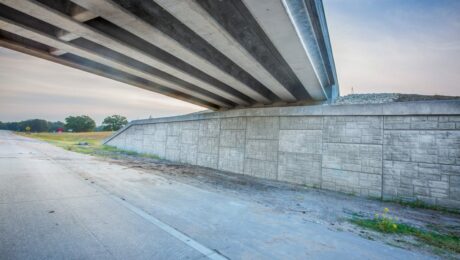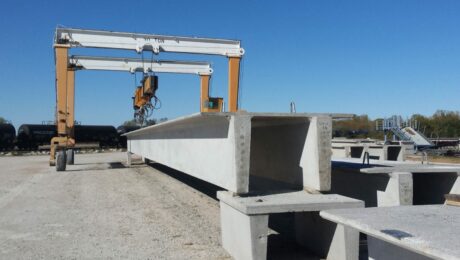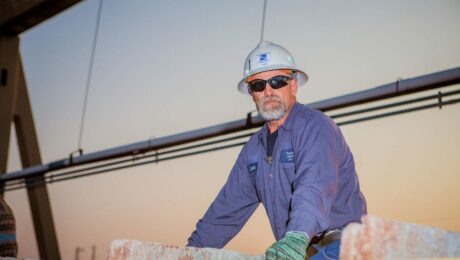Why Use Prestressed Concrete for Your Parking Garage Project?
Ever drive along the ground level of a parking garage and think about just how much weight is above you?
Ever wonder what’s holding it all up?
Sure there are those giant pillars on the sides and in the middle. But there’s a lot of concrete going on between them with seemingly nothing supporting it.
You can thank prestressed concrete for your safety.
What is prestressed concrete?
Prestressed concrete is, well, exactly that. It’s concrete and steel in which tension was induced long before any weight was put on it. It’s often used in long-spanning projects such as bridges, tall buildings, and parking garages.
Why is prestressed concrete great for parking garages?
Space is a premium in parking garages, and the fewer of those huge beams the better. To ensure there are long spans of parking spots on all levels, using prestressed concrete ensures that the structure is strong and safe enough for the traffic that runs over it every day.
With prestressed concrete, high-strength steel tendons are placed between two abutments and stretched to 70 to 80 percent of their ultimate strength. Concrete is poured into molds around the tendons and allowed to cure.
Applying the initial compression allows the concrete to better handle the external loads that parking garage surfaces face.
Because many parking garages need to be as sleek and/or slender as possible, prestressed concrete is ideal because it has greater shear strength and fatigue resistance.
Before you start your next parking garage project, talk to us about prestressed concrete! You and everyone who uses the garage will be glad you did.
- Published in Prestressed Concrete Info
What Kind of Projects are Prestressed Concrete Slabs Typically Used For?
Using prestressed concrete is a great way of ensuring strength, durability, and longevity of your building project.
But it’s not always necessary. Certain types of projects are better candidates for prestressed concrete than others.
Prestressed concrete is more often used in long-spanning projects with wide open spaces, such as:
- Bridges
- Parking garages
- Tall buildings
- Gymnasiums
- Shopping centers
What do all of these have in common? Long spans of concrete with heavy loads applied every day.
Think about a bridge. Think about how much weight and pressure is put on that long surface every day. Stress, stress, and more stress. If it’s not ready for that, cracks can form and strength becomes an issue.
When you use prestressed concrete to build a bridge, however, it’s better prepared for the pressure because the pretension applied helps improve the concrete’s bendability and structural flexibility.
Prestressed concrete has greater shear strength and fatigue resistance, making it the ideal choice for sleek and/or slender structures that require a large span of wide open space, such as parking garages, shopping centers, gymnasiums, and cafeterias.
Before you start your next project, consider using prestressed concrete as a way of providing strength and stability, all while reducing the risk of cracks!
Interested in using us for your next project? Talk to us about prestressed concrete!
- Published in Prestressed Concrete Info
Prestressed Concrete vs. Reinforced Concrete
Prestressing and reinforcing are two of the main ways of ensuring concrete’s durability and longevity.
And while both provide extra levels of protection and strength, they do so in distinctly different ways.
How does compression work with prestressed concrete?
With prestressed concrete, initial compression is applied to the concrete before ever being exposed to an external load. This initial compression is introduced by high-strength steel wire located in the concrete section.
In prestressing, those steel cables are stretched before the concrete is poured around them. Upon attempting to return to their normal length, the cables become stronger. The end result is concrete with greater tensile strength.
This is why prestressed concrete is often used on long-spanning projects such as bridges, tall buildings, gymnasiums, and parking garages.
What is reinforced concrete used for?
Reinforced concrete is similar in that steel rods, or rebar is inserted into the concrete ahead of the pour. Once the concrete is poured, vibrations are used to remove air pockets and evenly distribute the material.
This process often allows for the customization of shapes and sizes, which is helpful and effective in a variety of architectural projects. Reinforced concrete is often used in columns, foundations, dams, and highways.
Both prestressing and traditional reinforcement are very important to ensure the strength and quality of the concrete. Deciding which concept to use usually depends on the type of project, as prestressing isn’t always necessary.
Before you start your next project, talk to us about your options!
- Published in Prestressed Concrete Info
How to Limit Concrete Cracks with Prestressed Concrete
No matter how much wishing and hoping we do, one unfortunate fact of life is this: concrete cracks. It’s a shame, really.
Cracks are bad for a variety of reasons, such as the threat of moisture seeping in and reduced strength. Plus, it just looks bad. Fortunately, there are ways to limit this pesky truth, and one of the best ways is by prestressing the concrete.
With prestressed concrete, initial compression is applied to the concrete before ever being exposed to an external load. This initial compression is introduced by high-strength steel wire located in the concrete section.
High-strength steel tendons are placed between two abutments and stretched to 70 to 80 percent of their ultimate strength. Concrete is poured into molds around the tendons and allowed to cure.
Applying the initial compression allows the concrete to better handle the external loads, particularly in large, long-spanning projects such as bridges, tall buildings, gymnasiums, and parking garages.
Using prestressed concrete benefits designers and builders, as it allows for lighter and shallower concrete structures without compromising strength.
How Does Prestressed Concrete Work?
Ok, so how does this work? Good question.
Think of a row of books on a bookshelf. If you wanted to move those books all at once, ample pressure needs to be applied to both ends so the books all move together. Once lifted from the bookshelf, the pressure applied before the lift is sufficient to keep the books from falling downward due to gravity.
With concrete, the pretension applied before being subject to external loads helps improve the concrete’s bendability and structural flexibility, which helps avoid cracks.
Prestressed concrete has greater shear strength and fatigue resistance, making it the ideal choice for sleek and/or slender structures.
Need More Info? Contact Us!
Before you start your next project, consider using prestressed concrete as a way of providing strength and stability, all while reducing the risk of cracks! Contact us today to learn more or discuss your project.
- Published in Prestressed Concrete Info






